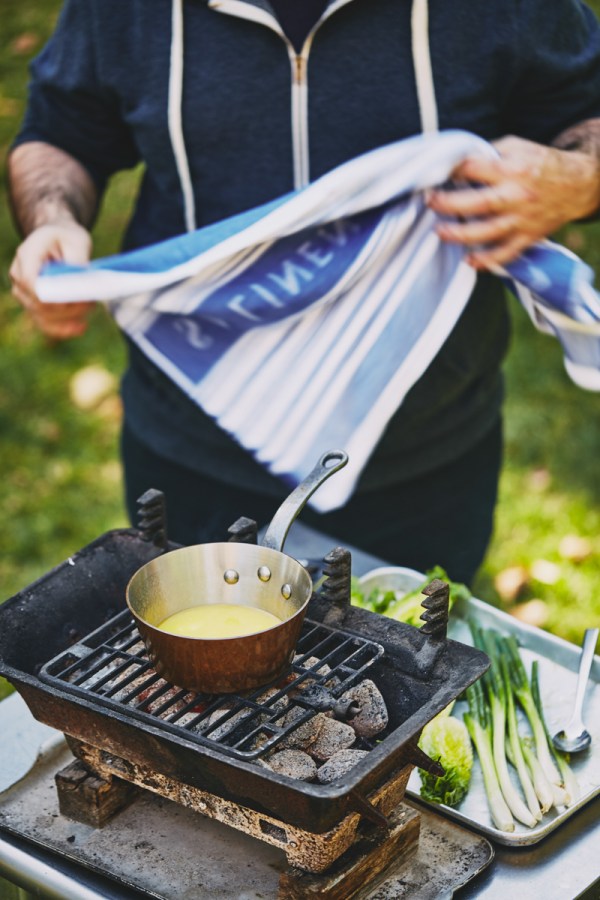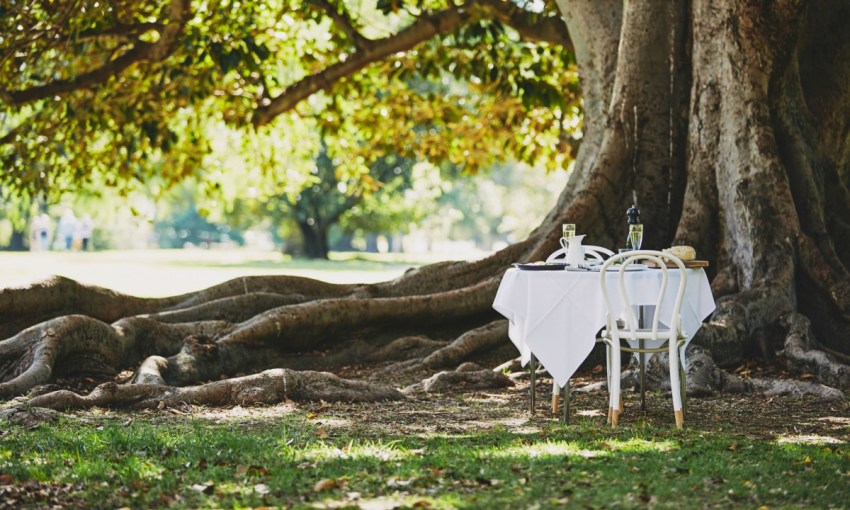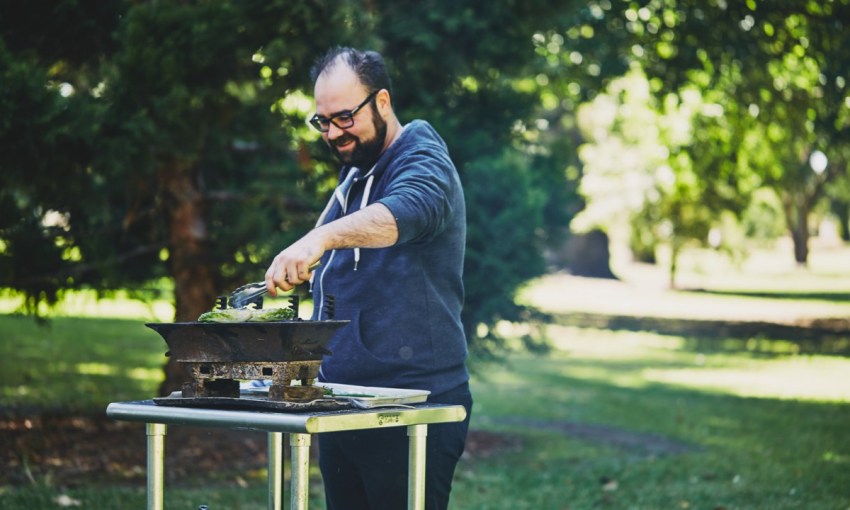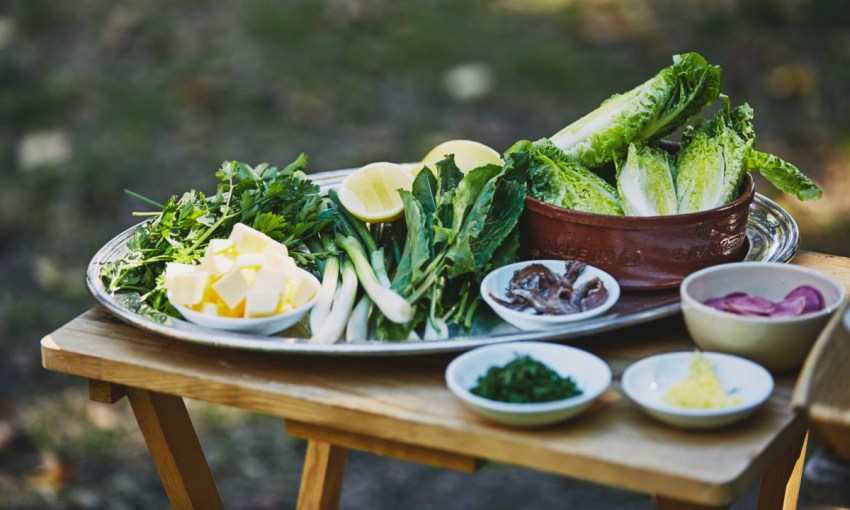Botanic Gardens Restaurant head chef Paul Baker stuck near his natural habitat for his stint on the public BBQ, opting to transform some lettuce and onions into a smokey and full-flavoured dish using a dodgy hibachi set-up in Botanic Park.
Paul Baker takes on the public BBQ
Although Paul Baker has succeeded in turning one of Adelaide’s cornerstone restaurants from a safe and staid eatery into something exciting and nationally-revered without upsetting anyone in the process, he’s very modest.
As well as being clearly talented, Paul is a gold mine of kitchen tricks and tips. During our time with him, we learnt a new way to cook quinoa and also that clapped out frying pans can be saved if the bottom is coated with greaseproof paper each time they’re used.
More than to himself, he credits the recent success of the Botanic Gardens Restaurant to its surrounds – from where he and his kitchen team daily forage produce.
“It’s the use of all of the herbs and fruit and vegetables from the Gardens,” says Paul. “I probably have the biggest kitchen garden in the country – it’s 150 or 160 hectares – and the Gardens are really amazing, they let us use whatever we like within reason.”
But, of course, the drive to get the most from the restaurant’s unique setting originates with Paul. Although he started his career in his home state of NSW – working in Aria under Matt Moran and eventually becoming head chef at the two-hatted Pello – Paul felt an immediate affinity for South Australia’s primary industries when he moved here after marrying wife Annabelle.
“We have an ingrained appreciation for good local produce here,” says Paul. “It’s not hard to sell South Australians good local lamb or good local lobster because they’ve grown up on it.
“It’s the same with wine, everyone knows their wines. Whereas in New South Wales and Melbourne, you go to a bottle shop there’s just wines of the world – there’s no appreciation for the local.”
Combining the herbs, fruit and vegetables pulled from the Gardens with other ingredients from small, local suppliers, Paul has instituted a style of cooking at the restaurant that puts the produce at the centre of the meal.
“Our ethos is just we cook food that is really in season and it’s not over-worked – it’s simply grilled, with good salt, good olive oil and that’s kind of the basis of everything that we do,” says Paul.
“You find with chefs the older they get and more mature they get the less they put on the plate. A lot of younger chefs over-do things because they think that’s the way of showing how good they are. It’s a hard lesson to learn.”

Paul prepares the dressing on the hibachi
He brings this approach to our session on the BBQ – this time a small charcoal grill set up in Botanic Park – which he is using to char lettuce and spring onions before combining a warm buttery dressing in a pan over the coals.
Paul was keen to make the dish “achievable” and says it demonstrates his belief in how the simplest things can be the most flavoursome.
“Everything tastes nice when you’ve given it a bit of grilling and smoking,” he says. “Especially if you’re a vegetarian, something like this really makes you feel like you’ve eaten a wholesome meal from something as simple as a lettuce and some onions.”
It’s not a given that dishes made with Paul’s straightforward ideals will find acceptance in the fine dining realm occupied by The Botanic Gardens Restaurant. But the venue has held on to its existing customer base even while forging ahead with new methods, largely because Paul’s changes have deliberately kept pace with the public’s education on food provenance.
As well as the local revolution happening in South Australia that has seen Farmers’ Markets explode in the last five years, Paul says mainstream entertainment has bolstered his cause.
“As much as everyone wants to bag TV shows, MasterChef has done a really great job of teaching people,” says Paul. “Now they understand that people do actually farm an animal, it’s not just boneless meat at the supermarket.”
If MasterChef helps us toward a future where more food tastes like Paul’s, then even the repetitive voice overs might prove to be worthwhile.
RECIPE: Charred baby romaine lettuce and burnt onions
Ingredients
– 4 whole baby romaine lettuces
– 4 whole spring onions
– 3 radishes shaved into cold water.
– Handful of Sorrel leaves
– 50ml extra virgin olive oil
– 100g unsalted butter
– 5 anchovies
– 1 lemon, zested and juiced
– 1/4 cup parsley, chopped
Method
Heat a pan on the coals and add butter until it starts to brown. Remove from the heat, add anchovies, lemon juice, zest and chopped parsley. Leave to stand somewhere warm.
Cut romaine lettuces in half and place on a tray with your spring onions. Coat with the olive oil and season with salt and pepper.
Once the grill is hot place the lettuce cut side down and grill until the leaves just start to wilt. Turn, but only grill for a further 10-15 seconds before placing on a plate. You still want to retain some crunch.
Grill your oiled and seasoned onions until they start to colour. Flip and then place on top of the romaine lettuce.
Dress with your anchovy and lemon dressing, shaved radish and sorrel.








